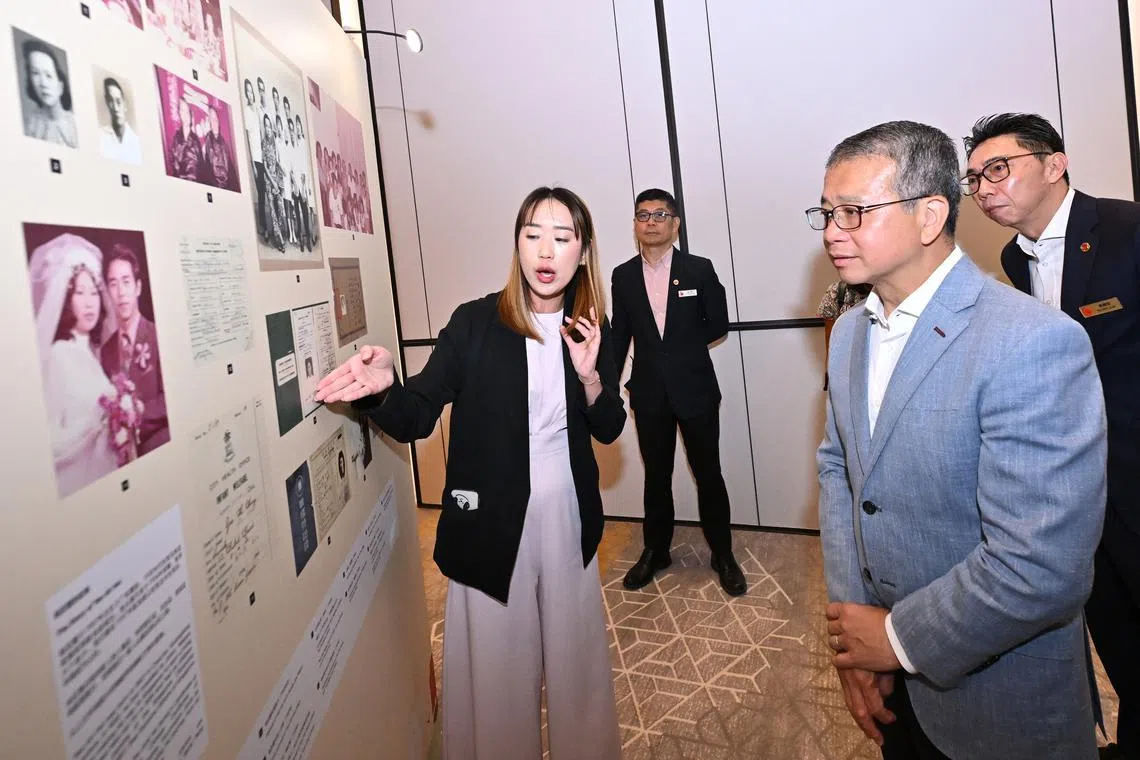Exhibition shines light on how Chinese migrants received Singapore citizenship back in 1957
Sign up now: Get ST's newsletters delivered to your inbox

Minister for Culture, Community and Youth Edwin Tong taking a wefie with students during the exhibition’s launch at the SCCCI building in Hill Street on April 7.
ST PHOTO: LIM YAOHUI
Follow topic:
SINGAPORE – A roving exhibition highlighting how Singapore introduced citizenship to many foreign-born Chinese residents after World War II was launched on April 7.
Its organiser is the Singapore Chinese Chamber of Commerce and Industry (SCCCI), which spearheaded a movement from 1947 to 1957 that led to the passing of the Singapore Citizenship Ordinance.
The ordinance established clear criteria that allowed long-term residents – those who had lived here for at least eight years – to be recognised as a Singapore citizen. The legal status granted them voting rights and legislative representation.
With the ordinance, a nationwide drive called Operation Franchise was rolled out on Nov 1, 1957, culminating in the granting of citizenship to over 220,000 people within three months.
Titled Sojourners To Citizens: The Citizenship Journey, the exhibition – which will feature artefacts and interactive presentations showcasing that period – will travel to schools, libraries, community centres and clan associations over the next year.
Zhangde Primary School and Nanyang Girls’ High School are among the schools that will host the exhibition in the following months.
Speaking at the exhibition’s launch held at the SCCCI’s building in Hill Street, Minister for Culture, Community and Youth Edwin Tong said anxious crowds, dressed in their best attire and holding citizenship application forms, waited outside that very building when Operation Franchise began.
At this epicentre of mass citizenship registration, people “entered as sojourners and strangers (and) left as citizens of Singapore”, he said.
As citizens, their outward appearance might look the same, but “inside, something had changed quite fundamentally”, he added.
Mr Tong said the origins of the day trace back to the early 20th century when Singapore was a bustling entrepot, with migrants arriving from various parts of Asia dreaming of a better future.
As migrants here, they toiled in plantations, built businesses and contributed immensely to the economic and cultural prosperity of Singapore, yet many remained stateless without the rights and recognition that come with citizenship. The ordinance changed that, he said.
Madam Foong Moy, 88, who registered for citizenship at the registration centre set up at the SCCCI Building back then, attended April 7’s exhibition launch ceremony with her husband, 91-year-old Chiang Chua Sam.
In a video shown at the ceremony, Mr Chiang said his wife applied for citizenship there as she used to work at a printing company in Hill Street, in one of the shops opposite the police headquarters.
He also registered for citizenship – in Chinatown with his mother. That is why their citizenship certificates’ serial numbers are close to each other, he said.
“The application process was simple. Go there, show them your document and fill out the form. Check that your information and signature are all correct. Once done, just wait at one side. After a while, you will receive your certificate with your name and you may leave,” Mr Chiang added.
In his speech, Mr Tong also recognised the SCCCI’s role in this turning point in history, which he said “set the stage for Singapore to emerge as an independent, multicultural nation”.
“They tirelessly lobbied the British colonial government, pushing for citizenship to be extended to Chinese migrants who had sunk their roots and made Singapore their home,” he said.

Minister for Culture, Community and Youth Edwin Tong during a tour at the exhibition’s launch at the SCCCI building in Hill Street on April 7.
ST PHOTO: LIM YAOHUI
The effort preceded the National Registration Act that came nearly a decade later, in 1965, which allowed almost a million people to register and receive their pink ICs.
Mr Tong said it was because of the precedent set by the 1957 ordinance that the residents did not do so as British subjects or Malaysians, but exclusively as citizens of Singapore.
This moment in history “reminds us that citizenship is about far more than papers and permits”, he added.
“With citizenship, our first citizens gained not just rights, but a sense of identity and a stake in this land. Beyond benefits, citizenship also comes with responsibility to care for other Singaporeans and to contribute to our shared future,” he said.
Mr Tong added that Singaporeans today inherit the choice made by the first citizens in 1957 to “step up and to shape the future of Singapore and the future of Singaporeans for tomorrow”.
SG60, which marks Singapore’s 60th year of independence in 2025, is one such occasion for Singaporeans to renew their belief in the kind of future they want to build, he said.

